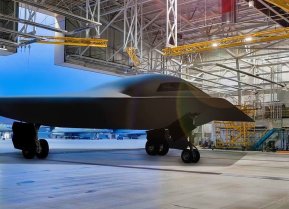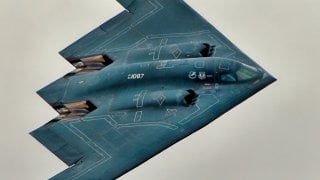Is the Air Force's B-2 Stealth Bomber Obsolete?
The U.S. Air Force's B-2 bomber has clear problems in that there are very few of them, and they are becoming old and obsolete with each passing day.
Few aircraft – few military platforms – strike a futuristic visual chord like the Northrup Grumman B-2 Spirit stealth bomber.
Painted dark grey, the B-2 is a “flying wing,” without a tail or elevators, with engine intakes embedded subtly within the fuselage.
Indeed, the world’s first-ever stealth bomber looks like something from a Batman film, something you’d expect Michael Keaton to emerge from, rather than an integral part of the US’s nuclear deterrence strategy.
But despite appearances, the B-2 is not futuristic; the B-2 isn’t even up to date, at least according to many experts.
Instead, the once-cutting-edge B-2 has quickly become a dated piece of technology – fueling fears that the stealth bomber is ill-equipped to contribute to a conflict against rivals with sophisticated air defense technology, i.e., China and Russia.
B-2 Bomber: A Demanding Role
Today, stealth technology is a default feature of new fighters and bombers. But in the 1970s, stealth was a novel concept. The idea was simple: design an aircraft that deflected or absorbed radar signals to the point where the aircraft was essentially invisible to radar.
Such an aircraft could operate (behind enemy lines if needed) while avoiding radar detection – and the weapons that depend upon radar for targeting/guidance.
To detect such an aircraft, adversaries would need to rely upon less reliable detection methods, such as human observation, infrared scanners, and acoustic locators. Understandably, the US, embroiled in the climaxing Cold War, was deeply interested in applying stealth technology to an airframe.
Developed in secret at Area 51, the B-2 Spirit stealth bomber was crafted to perform long-range penetration missions, which would allow the bomber to deliver ordnance (including nuclear weapons) behind enemy lines.
To penetrate enemy air space successfully, the B-2 was designed around stealth technology.
To reduce the B-2 radar observability, the bomber was designed without a fuselage, tail, or elevators. The streamlined design had benefits beyond reducing observability; the streamlined design enhanced the B-2’s range and efficiency, allowing the bomber to travel 6,900 miles before refueling.
In addition to a reduced radar signature, the B-2 also featured reduced acoustic, infrared, and visual signatures. To reduce the B-2’s visual signature, the bomber was coated with an anti-reflective paint, a dark grey color that blends well into the surrounding sky.

The B-2 is believed to have an upward-facing light sensor that instructs the pilot at which altitude to fly to best match the illuminance of the sky.
Similarly, the B-2 has a sensor that alerts the crew when creating a contrail and advises altitude changes to prevent contrails.
In the 1980s and 90s, when the B-2 bomber was being developed, the bomber’s stealth features were indeed cutting edge.
But times have changed. Air defense systems have advanced significantly since the B-2 inception, suggesting that the B-2 may not be equipped to perform long-range penetration missions against current defense technologies.
Is the B-2 Stealth Bomber Out of Date?
According to Interesting Engineering, the B-2 is “woefully outdated in some respects to modern aircraft. T
he major handicap [the B-2] possess[s] is their lack of wireless communication.” The Air Force is working to upgrade the B-2, however, to enable wireless communication. “To this end, Northrop Grumman and the U.S. Air Force have just completed a test that enables wireless data transfer between ground-based assets and the B-2 in flight. This function is vital in modern combat to allow mission data to be updated on the hop without being entered manually.”
But the upgrades are just a short-term fix, a stopgap. The B-2’s replacement – the B-21 Raider – is already under development and is expected to join the force within the next decade. So, the once-vaunted B-2 is already slated for retirement.
Why? In part because war planners don’t believe the B-2 would survive in a conflict against China or Russia, which possess sophisticated radar detection and surface-to-air missile systems.
The B-21, meanwhile, is being designed to survive in modern, contested airspaces. And once the B-21 is introduced to the force, the B-2 (and B-1) will need to be retired “because Air Force Global Strike Command wouldn’t have enough people to fly and maintain all four types [of bombers],” Air and Space Forces Magazines reported.
Giving way to the B-21 Raider
On sight, the B-21 looks strikingly like the B-2. The B-21, like the B-2, is a flying wing design coated in exotic radar-dampening materials. But the B-21 is advanced, a generation beyond the B-2.
“In comparison to the B-2 stealth bomber it will replace,” NBC reported, “the B-21 will use newer radar-absorbent materials that should give it an even smaller radar signature yet cost a lot less in upkeep than the maintenance-intensive 1980s technology on the B-2.”
And once the B-21 is available, it may cause “China’s military to realize that it can’t count on a preemptive missile strike to sufficiently neutralize U.S. air power should it try to seize Taiwan – and maybe deter it from making the attempt.”
About the Author
Harrison Kass is a defense and national security writer with over 1,000 total pieces on issues involving global affairs. An attorney, pilot, guitarist, and minor pro hockey player, Harrison joined the US Air Force as a Pilot Trainee but was medically discharged. Harrison holds a BA from Lake Forest College, a JD from the University of Oregon, and an MA from New York University. Harrison listens to Dokken.
All images are Creative Commons.


